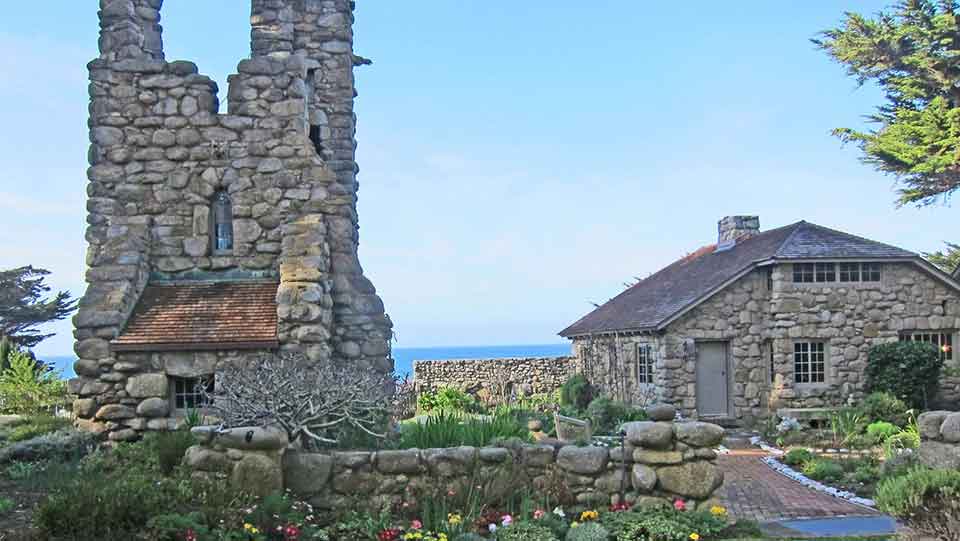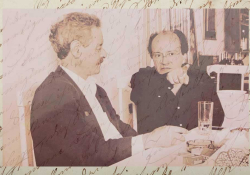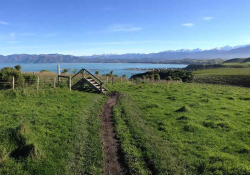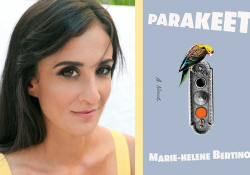“My ghost you needn’t look for”: Searching for Jeffers in Carmel

The Venice of my birth, a far cry from Casanova’s Serene Republic, whose spectre tourists chase at the tune of hundreds of euros a day, had already been pimped out to cruise ships by the time I had learned to walk in the late 1980s. A nautical stone’s throw from its noxious canals, life on the mainland was even worse: Edison and other petrochemical giants had long since turned the port of Marghera into a toxic wasteland whose refuse streamed into the Venetian lagoon’s ancient salt marshes, turning them into putrid putty.
After my family left Venice, my parents often reminded me of the unfettered excitement that seized me not long after we relocated to Abu Dhabi, the capital of the United Arab Emirates. Unlike Venice, Abu Dhabi felt alive; like all boom towns, its air was suffused with the aroma of endless possibilities. Nevertheless, it didn’t take long for that aroma to transform into an altogether different tang, one which reeked of nomadic desperation and physical impermanence. The minute I allowed myself to trust a landmark, or to grow comfortable at the sight of a particular building or street, they simply vanished, replaced—almost overnight, it seemed—by larger, uglier versions of their previous incarnations, as the city planners attempted to keep pace with Abu Dhabi’s breakneck development.
The impermanence grew increasingly painful and unsettling as time went by, a sentiment reinforced by my father’s stories in the evenings when he returned home from work. An architect, my father often voiced his frustration at his employers’ shortsightedness, including their stubborn insistence on using subpar construction materials—utterly unable to withstand the perpetual erosion of sand, water, and sun—for the various projects he designed and built. After all, Abu Dhabi’s economy rested entirely on the principle of enforced impermanence: the flimsier a building, the quicker one had to replace it, thus directly propping up the city’s businesses, many of which relied on the buzz of twenty-four-hour construction sites. The oldest newspaper clipping still in my possession from those days is entitled “Writing on Water: Floating island to spell out poem written by Sheikh Mohammed.” The article refers to the plan—later completed in 2015—to build a boardwalk-cum-breakwater surrounding the artificial island of Palm Jebel Ali in the shape of lines of poetry penned by Dubai’s ruler, Sheikh Mohammed bin Rashid Al Maktoum: “Take wisdom from the wise / It takes a man of vision to write on water / Not everyone who rides a horse is a jockey / Great men rise to greater challenges.” My first impression, which hasn’t changed in the intervening years, was that it was a jaw-dropping synthesis of doggerel and megalomania; unfortunately, it can now be seen from space.
In retrospect, shaped as I was by these buoyant ecological nightmares, it seems all too fitting that I would fall in love with the work of the Californian poet Robinson Jeffers (1887–1962), which I chanced across roughly around the same I clipped that article out of a local newspaper. Although I would only form a fuller appreciation of Jeffers later on, his stern, instructive rhetoric provided a blueprint I would unconsciously follow, probably because Jeffers’s own vision was so utterly divorced from that of Venice’s greedy bureaucrats or Sheikh Mohammed’s pompous superficiality. “A poet is one who listens,” Jeffers wrote in a late untitled poem, “To nature and his own heart,” and his poetry, often inscrutable to me at the time, sought to answer questions crucial to us all in a far more sincere and humane manner than life in those island-cities had previously led me to think was possible. “What’s the best life for a man?” Jeffers asked in the same poem, “To ride in the wind. To ride horses and herd cattle / In solitary places above the ocean on the beautiful mountain.” To Jeffers, stories of “man’s importance,” like Venice’s marketized past or Sheikh Mohammed’s palm-shaped island, were “lies / Best told by fools.”
Everything stank of fakery, snobbery, and mindless indolence; unsurprising for a town where the average house goes for two million dollars.
Half a lifetime later, I found myself in a car alongside my partner Zinzi, driving up the Pacific coast on State Route 1, as we left Los Angeles to attend the ALTA conference in Oakland in October 2016. As we approached Carmel Bay, we pulled off the highway and, filled with a mixture of excitement and naïveté, I took in my first sights of Carmel-by-the-Sea, Jeffers’s lifelong home. Probably long ago, I had made the conscious decision to not look up any pictures of the small California city or to educate myself on how that place had changed in the years since the poet’s death. My most current piece of information at the time was that Clint Eastwood had once served as its mayor. I had refused to allow anyone except Jeffers to be my guide, and thus I fully—and foolishly—expected to bask in the glory of Carmel’s “wild rock coast” and its “reckless wind,” to spend a few, quiet hours in a land “heavy with redwood,” where “the best trees in the canyon / Stand in the shadow of its fall.” Almost needless to say, I found nothing of the sort. Instead, what greeted us was one of the most twee places on earth I’d ever seen, and I don’t mean that as a compliment. Ocean Avenue, which slices horizontally across town, leading to the beach and the Pacific, was a Disneyland for the middle-aged wealthy, a wide, manicured boulevard fronted by wine cellars, tasting rooms, galleries, and delicatessens, many of which were housed in faux cottages that looked like they’d been ripped out of Hansel and Gretel. Everything stank of fakery, snobbery, and mindless indolence; unsurprising for a town where the average house goes for two million dollars.
However, the poet’s old home, a compound that includes Tor House, which Jeffers honed his stonemasonry on, and Hawk Tower, the Irish-inspired lookout that he built single-handedly, now “The Robinson Jeffers Tor House Foundation,” was still there, clinging to the old idea of itself, open to guided tours on weekends, perched up on Carmel Point, slightly south of the city’s hollow heart. A lone relic of Carmel’s actually artistic, more ecologically balanced past. It was, at least, pleasingly devoid of the picture-snapping tourists that filled Ocean Avenue. It isn’t difficult to think of how Jeffers would have viewed the transformation of Carmel-by-the-Sea, from the artists’ colony he had chosen to move to, into what it is today: Santa-Barbara-by-Big-Sur. These lines from “Shine, Republic” give us a clue: “in one noble passion we are one; and Washington, Luther, Tacitus, Aeschylus, one kind of man. / And you, America, that passion made you. You were not born to prosperity, you were born to love freedom. / You did not say ‘en masse,’ you said ‘independence.’ But we cannot have all the luxuries and freedom also. / Freedom is poor and laborious.”
Although Carmel had experienced its first big burst of attention with the arrival of such artists as Mary Austin, Jack London, George Sterling, and Arnold Genthe, many of them fleeing San Francisco after its 1906 earthquake, it appears that drawing such types to Carmel Bay had been part of the real estate ploy to turn this sleepy corner into prime real estate.
Yet on rereading some of Jeffers’s poems, it began to be clear that he may have actually foreseen such a turn of events. These lines are drawn from the poem “Tor House,” which was included in his volume Cawdor (1928): “If you should look for this place after a handful of lifetimes: / Perhaps of my planted forest a few / May stand yet, dark-leaved Australians or the coast cypress, haggard / With storm-drift; but fire and the axe are devils.” The trees he describes are still there, although much of the land around them has been built on, and what the poems couldn’t tell me, I supplemented with the fine critical and biographical literature that has emerged since Jeffers’s death, which proved indispensable in filling in the gaps.
Although Carmel had experienced its first big burst of attention with the arrival of such artists as Mary Austin, Jack London, George Sterling, and Arnold Genthe, many of them fleeing San Francisco after its 1906 earthquake, it appears that drawing such types to Carmel Bay had been part of the real estate ploy to turn this sleepy corner into prime real estate. Jeffers may have unwittingly fallen into the trap of developers long before writing those cautionary lines in “Tor House.” As Monica Hudson has pointed out, even the hamlet’s very name had been coined by Abbie Jane Hunter’s real estate company in 1892 in order to help engineer exactly what later transpired: the artists were the worms on the hook used to lure the rich in, thereby inflating land prices. It wasn’t long before Jeffers himself was drawn into the scam. In the late 1920s, a Carmel realtor placed an ad for plots in the local paper with the words “Carmel, the Home of Jeffers” emblazoned across it. The changes, relatively gradual as they were during the poet’s lifetime, clearly had an effect on Jeffers. As Melba Bennett noted in a volume of essays edited by Robert Brophy, Robinson Jeffers: Dimensions of a Poet (Fordham, 1995), the famously reclusive Jeffers had been forced to go on a public reading tour in 1941 in order to pay a $1,600 charge—$28,000 in today’s currency—leveled by the Department of Sanitation “to extend sewer lines to take care of real estate development on Carmel Point.” Indeed, as Brophy himself made plain: “Jeffers was almost fanatically intent on shutting out the hordes of humanity which he anticipated would overflow from Carmel to shatter his privacy. Developers led his list of villains.”
By the time we left Carmel on that first trip, I was only too happy to get back on the road to Oakland and couldn’t get away from it fast enough. I had sought Jeffers—or rather his spirit—and instead found only frustration. Subsequent visits haven’t improved on that initial impression. Whatever charm Robinson and his wife, Una, had found there in 1914 has since been obliterated—in fact, I think of Carmel as the living negation of Jeffers’s philosophy of inhumanism or, in other words, the attempt the effort to extricate ourselves from our anthropomorphism before it’s too late, both for us and for the planet we live in—and the surviving fragments of that fabled past are now for sale in pricy boutiques. Just like Venice. Perhaps it was a fate too close to home. In the end, however, I had only myself to blame. I should have paid closer attention to the final lines of “Tor House”: “My ghost you needn’t look for; it is probably / Here, but a dark one, deep in the granite, not dancing on wind / With the mad wings and the day moon.”
Los Angeles












